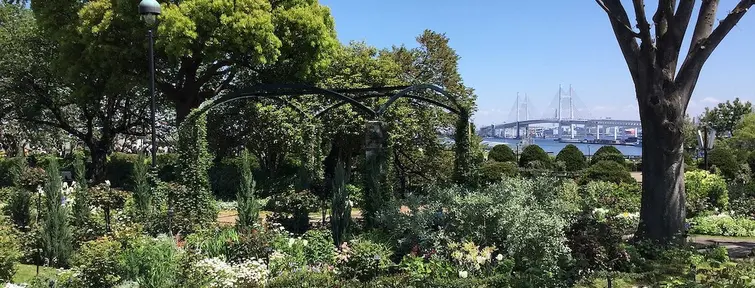Yamate 山手
- Published on : 03/11/2020
- by : SR
- Youtube
A city transformed by international trade, the Yamate and Motomachi neighborhoods give Yokohama a western feel.
Yamate/Bluff District Yokohama
The Yamate area of Yokohama, known as The Bluff, is a residential area that was settled by western foreigners following the opening of Yokohama as a Treaty Port at the end of the Edo Period. Chinese traders founded the nearby Yokohama Chinatown in 1859.
History of Yamate/The Bluff
At first the lowland area of Kannai was where foreigners were allowed to build their houses,warehouses and godowns, but as their number increased the hill side location of Yamate became occupied, firstly by British troops detailed to protect the British Consul-General, Sir Rutherford Alcock and the British Consulate, as well as the wider international community.
Over the subsequent years, well-to-do foreigners began to build their residences in the area and today the international schools, sports clubs, theaters and places of worship bear witness to the continuing western influence on this attractive, prosperous, residential area.
The majority of historic buildings on The Bluff were built after the Great Kanto Earthquake of 1923 which destroyed so many of the earlier structures.
Yamate Attractions
Yokohama Foreign General Cemetery
The Yokohama Foreign General Cemetery was established in 1854 when a sailor, Robert Williams, on Commodore Perry's flagship The Mississippi died after a fall on Perry's second voyage to Japan. Permission was asked of the Japanese shogunal authorities to bury the sailor onshore and to provide a resting place for any future Americans who died in Japan. Part of the grounds of Zotokuin Temple were set aside and have since become the Yokohama Foreign General Cemetery. An interesting museum in the gate house details some of the most famous people buried in the cemetery and also provides a map of how to visit their graves. In addition there are interesting panel displays of photos of Yokohama and details of some of the fascinating people and events associated with Yokohama during its early history as a Treaty Port when foreigners first began to live and visit Yokohama.
Christ Church Yokohama
Christ Church (Yamate Seikokai) is an historic Anglican church dating originally from 1901. The first Christ Church, built in red brick imported from Glasgow by British architect Josiah Conder in 1901, was itself a replacement for the Garrison Church built in the 1860's to serve the Anglican community in Yokohama. Conder's building was destroyed in the Great Kanto Earthquake of 1923. The church we see today was completed in 1931 but was damaged by US bombing in World War II and again by a fire in 2005.
Bluff No. 234
Bluff No. 234 was built as apartments for foreigners in 1927 after the 1923 Great Kanto Earthquake. Altogether there are four apartments in the two-story property, which is somewhat unusual as houses on The Bluff tended to be single units. The apartments were part of the reconstruction of the area following the earthquake.
Berrick Hall
Berrick Hall is the former Spanish-style mansion of the British businessman B.R. Berrick (1878-1972). It was designed by the American architect J.H. Morgan (1868-1937) in 1930 and post-dates the 1923 Great Kanto Earthquake. Berrick Hall is the largest pre-war foreign residence in Yamate.
British House
The British House was built in 1937 as the British consular residence. The building was designed by the Shanghai branch of the British Office of Works. The British House Yokohama is now part of the Rose Garden of Minato-no-mieru-oka Park. The roses draw many tourists when they bloom from April to June and again from October to November.
Bluff No. 111
Bluff No. 111 is a Spanish-style mansion designed by the American architect J.H. Morgan for his compatriot J. E. Raffin in 1926. J.H. Morgan also designed Berrick Hall and the first Marunouchi Building in Tokyo. Bluff No. 18 Bluff No. 18 is located in the Yamate Italian Garden. It was first built as a foreigners' residence following the Great Kanto Earthquake. After World War II the house became the parish house of the Yamate Catholic Church until 1991.
Diplomat's House
The Diplomat's House was originally the house of diplomat Sadatsuchi Uchida (1865-1942) in Shibuya. It was moved to the Italian Garden in 1997. The Victorian-style residence was designed by U.S. architect James McDonald Gardiner.
Museum of Tennis
The Museum of Tennis traces the history of tennis in Japan and still has a number of clay courts. Tennis was introduced into Japan along with a number of other sports such as baseball, soccer, rugby, golf and cricket during the period of intense westernization from the opening of Japan to the west in the late 1860's to the turn of the century. Lawn tennis only began in England in 1874 and had spread to Japan just two years later with the first match played in 1876. The Ladies Lawn Tennis and Croquet Club was founded here in 1878.
Yamate Museum
The Yamate Museum is now part of the Yamate Jubankan restaurant and is the only remaining Western-style, wooden residence to survive the devastating 1923 Great Kanto Earthquake.
Ehrismann Residence
The Ehrismann Residence was designed by the famous Czech-American architect Antonin Raymond (1888-1972), a disciple of Frank Lloyd Wright, as a residence for Swiss businessman Fritz Ehrismann in 1926. Antonin Raymond was the architect of a number of other projects in Japan including the Nanzan University campus in Nagoya, the wooden St. Alban's Church in Tokyo and the Gunma Music Center in Takasaki.
Iwasaki Museum
The Iwasaki Museum was once the Gaiety Theater that was first constructed in brick on this site in 1885. The Gaiety Theater was opened for the amusement of the area's foreign residents and was designed by the French architect, Paul Sarda. The Gaiety Theater was one of the first western theaters built in Japan and staged performances of Shakespeare and other western dramatists as well providing a venue for concerts of western music. The Gaiety Theater was completely destroyed in the Great Kanto Earthquake of 1923 and was then rebuilt, according to original plans, photographs and documents that had been preserved, in 1980.
Osaragi Jiro Memorial Museum
The Osaragi Jiro Memorial Museum celebrates the life and works of Haruhiko Nojiri (1897-1973) a writer of popular historical fiction in the Showa Period. His work was serialized in newspapers and magazines of the day. Osaragi was born in Yokohama but lived much of his life in nearby Kamakura, where he did much to preserve its natural heritage from the threat of development.
Getting to Yokohama Yamate District
By Train
The nearest stations to Yokohama's Yamate district are Motomachi-Chukagai Station on the Minato Mirai Line and Ishikawacho Station on the JR Negishi Line, both less than 10 minutes' ride from Yokohama Station.
The Akaikutsu Loop Bus also stops at the northern end of Yamate/The Bluff.




















